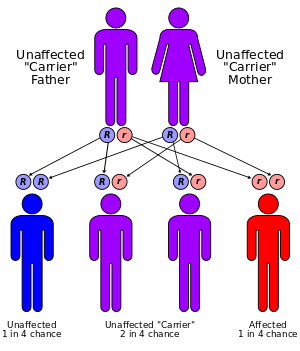Adenosine deaminase deficiency
| Adenosine deaminase deficiency | |
|---|---|
| Classification and external resources | |
| Specialty | hematology |
| ICD-10 | D81.3 |
| ICD-9-CM | 279.2 |
| OMIM | 102700 |
| DiseasesDB | 260 |
| GeneReviews | |
Adenosine deaminase deficiency (also called ADA deficiency or ADA-SCID[1]) is an autosomal recessive[2] metabolic disorder that causes immunodeficiency. It occurs in fewer than one in 100,000 live births worldwide.
It accounts for about 15% of all cases of severe combined immunodeficiency (SCID).[3]
ADA deficiency may be present in infancy, childhood, adolescence, or adulthood.[1] Age of onset and severity is related to some 29 known genotypes associated with the disorder.[4]
Pathophysiology
ADA deficiency is due to a lack of the enzyme adenosine deaminase. This deficiency results in an accumulation of deoxyadenosine,[5] which, in turn, leads to:
- a buildup of dATP in all cells, which inhibits ribonucleotide reductase and prevents DNA synthesis, so cells are unable to divide. Since developing T cells and B cells are some of the most mitotically active cells, they are highly susceptible to this condition.
- an increase in S-adenosylhomocysteine since the enzyme adenosine deaminase is important in the purine salvage pathway; both substances are toxic to immature lymphocytes, which thus fail to mature.
Because T cells undergo proliferation and development in the thymus, affected individuals typically have a small, underdeveloped thymus.[6] As a result, the immune system is severely compromised or completely lacking.
Genetics

The enzyme adenosine deaminase is encoded by a gene on chromosome 20. ADA deficiency is inherited in an autosomal recessive manner.[1] This means the defective gene responsible for the disorder is located on an autosome (chromosome 20 is an autosome), and two copies of the defective gene (one inherited from each parent) are required in order to be born with the disorder. The parents of an individual with an autosomal recessive disorder both carry one copy of the defective gene, but usually do not experience any signs or symptoms of the disorder.
Age of onset and severity is related to some 29 known genotypes associated with the disorder.[4]
Treatment
Treatments include:[7]
- bone marrow transplant
- gene therapy
- ADA enzyme in PEG vehicle [7]
On September 1990, the first gene therapy to combat this disease was performed by Dr. William French Anderson on a four-year-old girl, Ashanti DeSilva, at the National Institutes of Health, Bethesda, Maryland, U.S.A.[8]
In April 2016 the Committee for Medicinal Products for Human Use of the European Medicines Agency endorsed and recommended for approval a stem cell gene therapy called Strimvelis, for children with ADA-SCID for whom no matching bone marrow donor is available.[9][10]
References
- 1 2 3 Online Mendelian Inheritance in Man (OMIM) 102700
- ↑ Hirschhorn R, Vawter GF, Kirkpatrick JA Jr, Rosen FS (September 1979). "Adenosine deaminase deficiency: frequency and comparative pathology in autosomally recessive severe combined immunodeficiency". Clinical immunology and immunopathology. 14 (1): 107–20. doi:10.1016/0090-1229(79)90131-4. PMID 477037.
- ↑ Hershfield MS (October 2003). "Genotype is an important determinant of phenotype in adenosine deaminase deficiency". Current opinion in immunology. 15 (5): 571–7. doi:10.1016/S0952-7915(03)00104-3. PMID 14499267.
- 1 2 Arredondo-Vega FX, Santisteban I, Daniels S, Toutain S, Hershfield MS (October 1998). "Adenosine deaminase deficiency: genotype-phenotype correlations based on expressed activity of 29 mutant alleles". American Journal of Human Genetics. 63 (4): 1049–59. doi:10.1086/302054. PMC 1377486
 . PMID 9758612.
. PMID 9758612. - ↑ "Adenosine Deaminase (ADA) Deficiency". Archived from the original on 12 February 2008. Retrieved 2008-02-28.
- ↑ p347, The Immune System Peter Parham, Garland Science, London and New York, 2009
- 1 2 Management options for adenosine deaminase deficiency; proceedings of the EBMT satellite workshop (Hamburg, March 2006). Booth doi:10.1016/j.clim.2006.12.009
- ↑ Naam, Ramez (2005-07-03). "'More Than Human' - New York Times". The New York Times. Retrieved 2008-02-28.
- ↑ House, Douglas W., (1 April 2016) European Ad Comm backs Glaxo's stem cell therapy Strimvelis for rare autoimmune disorder, Seeking Alpha, Retrieved 13 April 2016
- ↑ "Summary of opinion1 (initial authorisation) Strimvelis" (PDF). European Medicines Agency. 1 April 2016. pp. 1–2. Retrieved 13 April 2016.